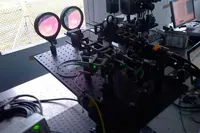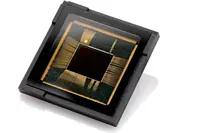Electronics News
Archive : 9 March 2016 год
 A tracking system called HYPERION based on eye-safe lasers could enable aircraft, unmanned aerial vehicles (UAVs) and even orbiting satellites to transmit vital data to ground stations more securely, quickly and efficiently.
A tracking system called HYPERION based on eye-safe lasers could enable aircraft, unmanned aerial vehicles (UAVs) and even orbiting satellites to transmit vital data to ground stations more securely, quickly and efficiently.
The development of HYPERION has been made through Innovate UK’s HITEA programme: a team including the University of Oxford with funding from the Engineering and Physical Sciences Research Council (EPSRC), and Airbus Group Innovations with Innovate UK support. The group says a proof-of-concept system with a range of 1km has been successfully tested in-flight, with work to extend this range underway.
As well as transmission of data from UAVs and satellites, HYPERION could also enable airliners of the future to offload huge amounts of technical and performance data gathered by on-board sensors to ground crews during final approach to an airport, speeding maintenance procedures and cutting turn-round times.
John Laughlin, aerospace programme lead at Innovate UK, said: “Collaborations such as these between industry and academia to develop new disruptive solutions to existing challenges are essential to the success of the UK aerospace sector.”
This optical system aims a laser with a wavelength of 1550nm from the ground towards the target aircraft, which is equipped with a reflector that captures the beam, modifies it with the data to be transmitted and then sends it back to the ground where it can be decoded and ‘read’.
Professor Philip Nelson, chief executive of EPSRC said: “This EPSRC funded research will potentially make aircraft and unmanned vehicles better connected and more resilient to outside interference.”
With its optimised aircraft tracking capability and secure high-speed data link, HYPERION is claimed to be less vulnerable to interception and jamming than current RF communications that rely on an increasingly crowded part of the electromagnetic spectrum. Unless alternatives are developed that can supplement radio communications, the researchers say, it will not be possible to cope with the huge volumes of data that need to be transmitted from the skies in years in come.
It is hoped that, with further development, HYPERION could begin to be introduced into commercial use within around three to five years.
Pic: HYPERION's first laser interrogator prototype
Author
Tom Austin-Morgan
Source: www.newelectronics.co.uk
 A 12Mpixel image sensor for smartphones from Samsung is claimed to improve the quality of mobile phone pictures. With 1.4µm pixels, the device takes advantage of Dual Pixel technology, previously applied only in digital SLR cameras. According to Samsung, the technology enables rapid autofocus and ‘premium’ image quality on mobile devices, even in low light situations.
A 12Mpixel image sensor for smartphones from Samsung is claimed to improve the quality of mobile phone pictures. With 1.4µm pixels, the device takes advantage of Dual Pixel technology, previously applied only in digital SLR cameras. According to Samsung, the technology enables rapid autofocus and ‘premium’ image quality on mobile devices, even in low light situations.
“With 12Mpixels working as a phase detection autofocus agent, the new image sensor brings professional autofocusing performance to a mobile device,” claimed Ben K Hur, vp of marketing with Samsung’s System LSI Business.
Dual Pixel technology features two photodiodes on the left and right halves of a pixel. As each pixel can detect phase differences in the perceived light, significantly faster autofocus has become possible. With such improvements, says Samsung, the image sensor ensures sharp images, especially for moving objects in poor lighting conditions.
The image sensor has features Samsung’s ISOCELL technology, in which the photodiodes in each pixel are isolated using a physical wall to reduce colour cross talk.
Constructed using chip stacking technology, the image sensor stacks a 65nm sensor and a 28nm logic chip.
Author
Graham Pitcher
Source: www.newelectronics.co.uk
 Barclays is opening up branch and office space around the UK, inviting businesses and individuals to build their digital and business skills through its Eagle Labs, which the bank hopes will encourage innovation in the future of fast growth sectors, in addition to UK manufacturing and production.
Barclays is opening up branch and office space around the UK, inviting businesses and individuals to build their digital and business skills through its Eagle Labs, which the bank hopes will encourage innovation in the future of fast growth sectors, in addition to UK manufacturing and production.
The bank says the Eagle Labs will provide access to resources including expert mentoring, event space, 3D printers and laser cutters. With a third Eagle Lab opening in Brighton this week after successful pilots in Bournemouth and Cambridge, Barclays announced plans to open up to 20 Eagle Labs this year, including in Birmingham and Huddersfield.
The spaces will be designed around the needs of local entrepreneurs, businesses and communities and tailored to suit regional economic strength in specific industries. The Labs will be supported by Barclays’ Digital Eagles and feature Incubators and MakerSpaces.
Incubators will target high-growth firms and entrepreneurs who are projecting 20% growth or more, giving fast growing businesses the space and resources to help them succeed. MakerSpaces will offer access to 3D printers and laser cutters. Meaning businesses will have access to the tools they need to rapidly produce and test prototypes without having to import from overseas, and can reduce the time and cost taken from concept to market.
At the launch of the Brighton Eagle Lab, Ashok Vaswani, CEO of Barclays UK announced: “Technology is transforming the speed at which start-ups can grow and scale. Simply having access to a 3D printer can now help people turn a clever idea into a business success overnight, and by providing practical resources alongside our financial expertise we intend to help people succeed.”
According to Barclays, the number of start-ups is at its highest in three years, up 3.86% nationally in the first half of 2015, however the number of high-growth businesses had declined, showing more must be done to supporting growing businesses thrive and survive.
Councillor John Beesley, Leader of Bournemouth Borough Council said: “As the fastest growing digital hub in the UK we were delighted that Bournemouth became home to one of the first Barclays Eagle Labs. The Eagle Lab is a key part of our drive to grow our digital economy which is backed by local partners including Silicon Beach and Silicon South.”
Barclays is the latest company to open an innovation lab. Last year Fab Lab UK opened its 19th lab in London
Author
Tom Austin-Morgan
Source: www.newelectronics.co.uk

